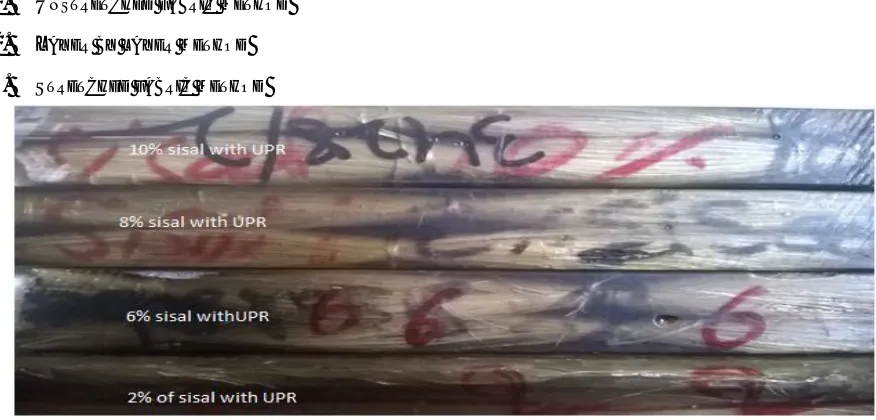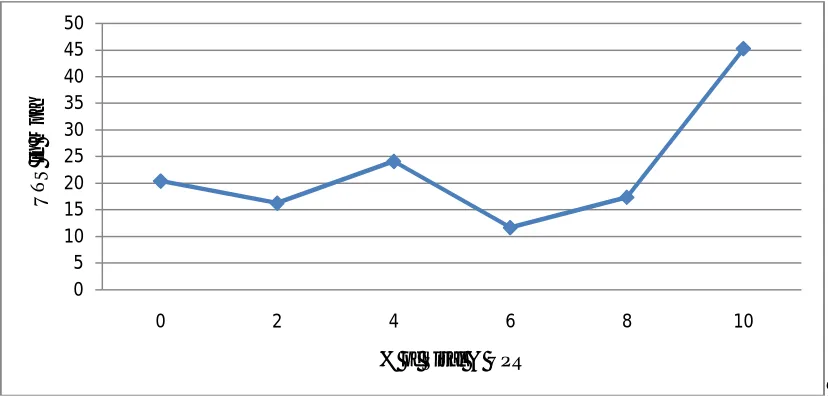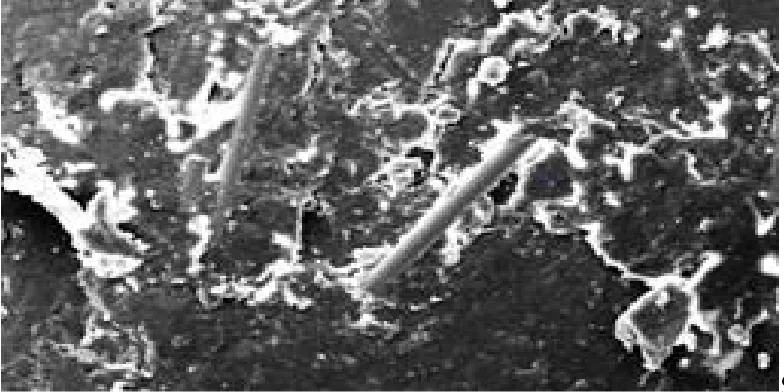Fabrication and Study of Mechanical
Properties of Sisal, Glass Fiber and MWCNTS
Reinforced Polymer
M.Chandrakanth
1, S.Shyam Sunder Rao
2, K.Srinivasulu Reddy
3M.Tech Student, Department of Mechanical Engineering, VNR VJIET Collage, Bachupalli, Hyderabad, India1
Associate Professor, Department of Mechanical Engineering, VNR VJIET Collage, Bachupalli, Hyderabad, India2
Professor, Department of Mechanical Engineering, Sreenidhi Institute of Science & Technology, Hyderabad, India3
ABSTRACT: Sisal fiber and glass fiber as the major reinforcements and multi walled carbon nanotubes (MWCNT) as
additional reinforcements are used to improve the mechanical properties of polymer composite with commercial resin ECMALON 9911 as the base material prepared by hand layup, stretched fiber and unstretched fiber processes. Test specimens prepared as per ASTM standards with different weight percentage of sisal, glass fibers and MWCNTs and tests were conducted. Improvement of mechanical properties like tensile strength, hardness of the hybrid composite material is observed. SEM images confirms that the compatibility of sisal and glass fiber with resin and the interfacial bonding between matrix and reinforcement.
KEYWORDS: Epoxy resin ECMALON 9911, Hand layup, Sisal fiber, Glass fiber, Carbon nanotubes (MULTY
WALL), Dies.
I. INTRODUCTION
A composite material can be defined as a combination of two or more materials that results in better mechanical properties than those of the individual components also used. In contact to metallic alloys, each material retains its separate chemical, physical, and mechanical properties [1, 2]. The two constituents are reinforcement and a matrix. The main advantages of composite materials are their high strength and high stiffness, combined with low density, when compared with bulk materials, allowing for a weight reduction in the finished part. Development of polymer composites with natural fibers and fillers as a sustainable alternative material for some engineering applications, particularly in aerospace applications and automobile applications are being developed. Natural fibers show superior mechanical properties such as stiffness, flexibility and modulus compared to glass fibers [3]. Some of the natural fibers are sisal, Jute, hemp, coir, bamboo and other fibrous materials. The main advantages of natural fibers are of low cost, light weight, easy production and friendly to environment [4, 6].
II. RELATEDWORK
MATERIAL PROPERTIES AND PROCESSING
BASIC SPECIFICATIONS OF VARIOUS MATERIALS USED IN THIS STUDY ARE GIVEN IN BELOW TABLE.1.
TABLE 1:MATERIALS AND ITS PROPERTIES
S. No Materials Specifications
1 Unsaturated polyester resin ECMOLAN 9911
Density: 1.13 g/cm3, UTS: 70Mpa, Flexural Strength:115 MPa Heat distortion temperature:102 0C
3 Glass fiber Density: 2.55-2.60 in (Mg/m3), UTS: 1950–2050 in (MPa), Thermal Conductivity: 1.2-1.35 in (W/m.K)
4 Multi-wall carbon nanotubes Density: 1.3 – 2, Strenght 5 Cobalt (Accelerator) Density: 0.98 g/cm3 6 Methyl Ethyl Ketone
peroxide (MEKP) Catalyst
Density: 1.17 g/cm3
METHODS OF SAMPLES PREPARATION:
THEY ARE SO MANY METHODS USED IN THE FIBER REINFORCED COMPOSITES.THREE MAJOR METHODS USED FOR SAMPLE PREPARATION ARE
1. UNSTRETCHED FABRIC METHOD
2. LAYER BY LAYER METHOD
3. STRETCHED FABRIC METHOD
Fig 1: Unsaturated Polyester Resin (UPR) reinforced with sisal fiber
The above figure shows the different weight percentages of Sisal fiber reinforced Unsaturated Polyester Resin.
Fig 2: Unsaturated Polyester Resin (UPR) reinforced with sisal and glass fiber
Fig 3: Unsaturated Polyester Resin (UPR) reinforced with sisal, glass fiber and MWCNTs
The above figure shows the equal weight percentage of Sisal, Glass fiber and 1% of Multi Wall Carbon Nanotubes reinforced with Unsaturated Polyester resin.
III.EXPERIMENTAL RESULTS
Ultimate Tensile Strength:
The tensile strength of sisal / sisal and glass fiber and reinforced Multi-wall carbon nanotubes hybrid composites is presented in table-5, 6, and 7. The mixing of carbon nanotubes increase the mechanical properties of the fiber reinforced composite materials. It is observed that the sisal and glass fiber composite is exhibiting higher tensile strength than the sisal fiber reinforced composite. The sisal / glass fiber hybrid composite tensile strength is higher than sisal reinforced composite but lower than glass fiber reinforced composite. The increase in tensile strength of hybrid composite is because of glass fiber content. It is observed that multi wall carbon nano tubes are mixed with the sisal, glass fiber with resin to increase the mechanical properties of the specimen.
Graph 1: UTS of sisal fibers reinforced Unsaturated Polyester Resin (UPR) in unstretched fabric method
0 5 10 15 20 25 30 35 40 45 50
0 2 4 6 8 10
U
T
S
i
n
M
pa
The above graph shows the different weight percentage of Sisal fiber reinforced unsaturated polyester Resin in Unstretched fabric method. In this method alignment of fibers into the die is zig zag.
Graph 2: UTS of sisal fibers reinforced Unsaturated Polyester Resin (UPR) in layer by layer method
The above graph shows the different weight percentage of Sisal fiber reinforced unsaturated polyester Resin in Layer by layer fabric method. In this method alignment of fibers into the die is layer by layer.
Graph 3: UTS of sisal fibers reinforced fiber reinforced Unsaturated Polyester Resin (UPR) in stretched fabric method
0 10 20 30 40 50 60 70
0 2 4 6 8 10
U
T
S
i
n
M
pa
% of Sisal & UPR
0 10 20 30 40 50 60 70
0 2 4 6 8 10
U
T
S
i
n
M
pa
The above graph shows the different weight percentage of Sisal fiber reinforced unsaturated polyester Resin in Stretched fabric method. In this method alignment of fibers into the die is strightly stiffed.
Graph 4: Comparison between all fabric methods of sisal fiber reinforced Unsaturated Polyester Resin (UPR)
The above graph shows the different fabric methods of sisal fiber reinforced Unsaturated Polyester Resin.
Graph 5: UTS of sisal & glass fibers reinforced Unsaturated Polyester Resin (UPR) in unstretched fabric method
The above graph shows the different weight percentage of Sisal and Glass fiber reinforced unsaturated polyester Resin in Unstretched fabric method. In this method alignment of fibers into the die is zig zag.
0 10 20 30 40 50 60 70
0 2 4 6 8 10
U
T
S
i
n
M
pa
% of Sisal & UPR
Unstretched
Layer by layer
Stretched
0 10 20 30 40 50 60
0 2 4 6 8 10
U
T
S
i
n
M
pa
Graph 6: UTS of sisal & glass fibers reinforced Unsaturated Polyester Resin (UPR) in layer by layer method
The above graph shows the different weight percentage of Sisal fiber reinforced unsaturated polyester Resin in Layer by layer fabric method. In this method alignment of fibers into the die is layer by layer.
Graph 7: UTS of sisal & glass fibers reinforced Unsaturated Polyester Resin (UPR) in stretched fabric method
The above graph shows the different weight percentage of Sisal fiber reinforced unsaturated polyester Resin in Stretched fabric method. In this method alignment of fibers into the die is strightly stiffed.
0 10 20 30 40 50 60 70
0 2 4 6 8 10
U
T
S
i
n
M
pa
% of Sisal & Glass
0 10 20 30 40 50 60 70 80
0 2 4 6 8 10
U
T
S
i
n
M
pa
Graph 8: Comparison between all fabric methods of sisal & glass fiber reinforced Unsaturated Polyester Resin (UPR)
The above graph shows the different fabric methods of sisal and Glass fiber reinforced Unsaturated Polyester Resin.
Graph 9: UTS of sisal & glass fibers reinforced MWCNT with Unsaturated Polyester Resin (UPR) in unstretched fabric method
The above graph shows the different weight percentage of Sisal fiber reinforced unsaturated polyester Resin in Unstretched fabric method. In this method alignment of fibers into the die is zig zag.
0 10 20 30 40 50 60 70 80
0 2 4 6 8 10
U
T
S
i
n
M
pa
% of Sisal & Glass
Unstretched
Layer by layer
Stretched
0 10 20 30 40 50 60
0 2 4 6 8 10
U
T
S
i
n
M
pa
Graph 10: UTS of sisal & glass fibers reinforced MWCNT with Unsaturated Polyester Resin (UPR) in layer by layer method
The above graph shows the different weight percentage of Sisal fiber reinforced unsaturated polyester Resin in Layer by layer fabric method. In this method alignment of fibers into the die is layer by layer.
Graph 11: UTS of sisal & glass fibers reinforced MWCNT with Unsaturated Polyester Resin (UPR) in stretched fabric method
The above graph shows the different weight percentage of Sisal fiber reinforced unsaturated polyester Resin in Stretched fabric method. In this method alignment of fibers into the die is strightly stiffed.
0 10 20 30 40 50 60 70
0 2 4 6 8 10
U
T
S
i
n
M
pa
% of Sisal & Glass with MWCNTs
0 10 20 30 40 50 60 70 80
0 2 4 6 8 10
U
T
S
i
n
M
pa
Graph 12: Comparison between all fabric methods of sisal & glass fiber reinforced MWCNT with Unsaturated Polyester Resin (UPR)
The above graph shows the different fabric methods of sisal, Glass fiber and MWCNT reinforced Unsaturated Polyester Resin.
Hardness Test:
Shore D hardness tester is used to determine the hardness of the fiber reinforced polymer composites. The 10 % wt of sisal fiber, hardness of the composite is increased compared to 10 % sisal and glass fiber. And the 10 % wt of sisal, glass fiber reinforced Multi-walled carbon nanotubes and 89 % of resin combination, the hardness is increased.
Graph 13: Hardness of Shore D hardness of the sisal, glass fiber and reinforced MWCNT with Unsaturated Polyester Resin (UPR)
0 10 20 30 40 50 60 70 80
0 2 4 6 8 10
U
T
S
i
n
M
pa
% of Sisal & Glass with MWCNTs
Unstretched
Layer by layer
The dispersion of Sisal, glass fiber reinforced Multi-walled carbon nanotubes in resin ECMALON 9911 was studied using SEM. After the completion of Scanning Electron Microscope test the observing results are good contact of the sisal, glass fiber, and reinforced Multi-walled nanotubes with resin. The Multi-walled carbon nanotubes are mixed with resin by using of magnetic stirrer in 5-12 min. The SEM images confirm proper mixing of nanotubes in resin and tubes are seen in SEM image in Fig.4.
Fig 4: SEM results in sisal, glass fibers with UPR
IV.CONCLUSION
The conclusion is, ultimate tensile strength and hardness values of the natural fiber reinforced polymer composites are observed. It can be concluded from the experiments with 10 % sisal & glass fiber reinforcement with 90 % of resin composite specimen’s tensile strength is 68.40 MPa and is higher than 10 % sisal fiber reinforcement with 90 % resin composite whose tensile strength is 66.48 MPa and 10 % sisal, glass fiber reinforced with 1% multi-walled carbon nanotubes with 89 % resin composite is 70.36 MPa. There is no improvement in hardness with the addition of sisal and glass fiber. There is marginal improvement in hardness when MWCNTs are added at 1%. The SEM images confirm proper mixing of nanotubes in resin and tubes are shown.
REFERENCES
[1] Madhusudhana reddy, and bharath S. Kodli, Experimental investigation of mechanical properties of sisal fiber and rice husk reinforced polymer composite, Journal of Mechanical and Civil Engineering, Vol. 11, Issue 4, AUGUST 2014.
[2] C. W. Nguong, S. N. B. Lee, and D. Sujan, A Review on Natural Fiber Reinforced Polymer Composites, International Journal of Chemical, Nuclear, Metallurgical and Materials Engineering Vol. 7, 2013.
[3] Olusegun david Samuel, Stephen agbo, and Timothy adesoye adekanye, Assessing Mechanical Properties of Natural Fiber Reinforced Composites for Engineering Applications, Journal of Minerals and Materials Characterization and Engineering Vol. 11, AUGUST 2012. [4] Chandramouli K, Srinivasa rao, and Pannirselvan, Strength Properties of Glass Fiber Concrete, ARPN Journal of Engineering and Applied
Sciences Vol. 5, APRIL 2010.
[5] K. Devendra, T. Rangaswamy, Evaluation of Thermal Properties of E-Glass fiber/Epoxy Composites Filled By Different Filler Materials, International Journal of Computational Engineering Research, Vol. 2, Issue.5 SEPTEMBER 2012.
[6] K. Devendra, T. Rangaswamy, Strength Characterization of E-glass Fiber Reinforced Epoxy Composites with Filler Materials, Journal of Minerals and Materials Characterization and Engineering, Vol. 1 NOVEMBER 2013.


